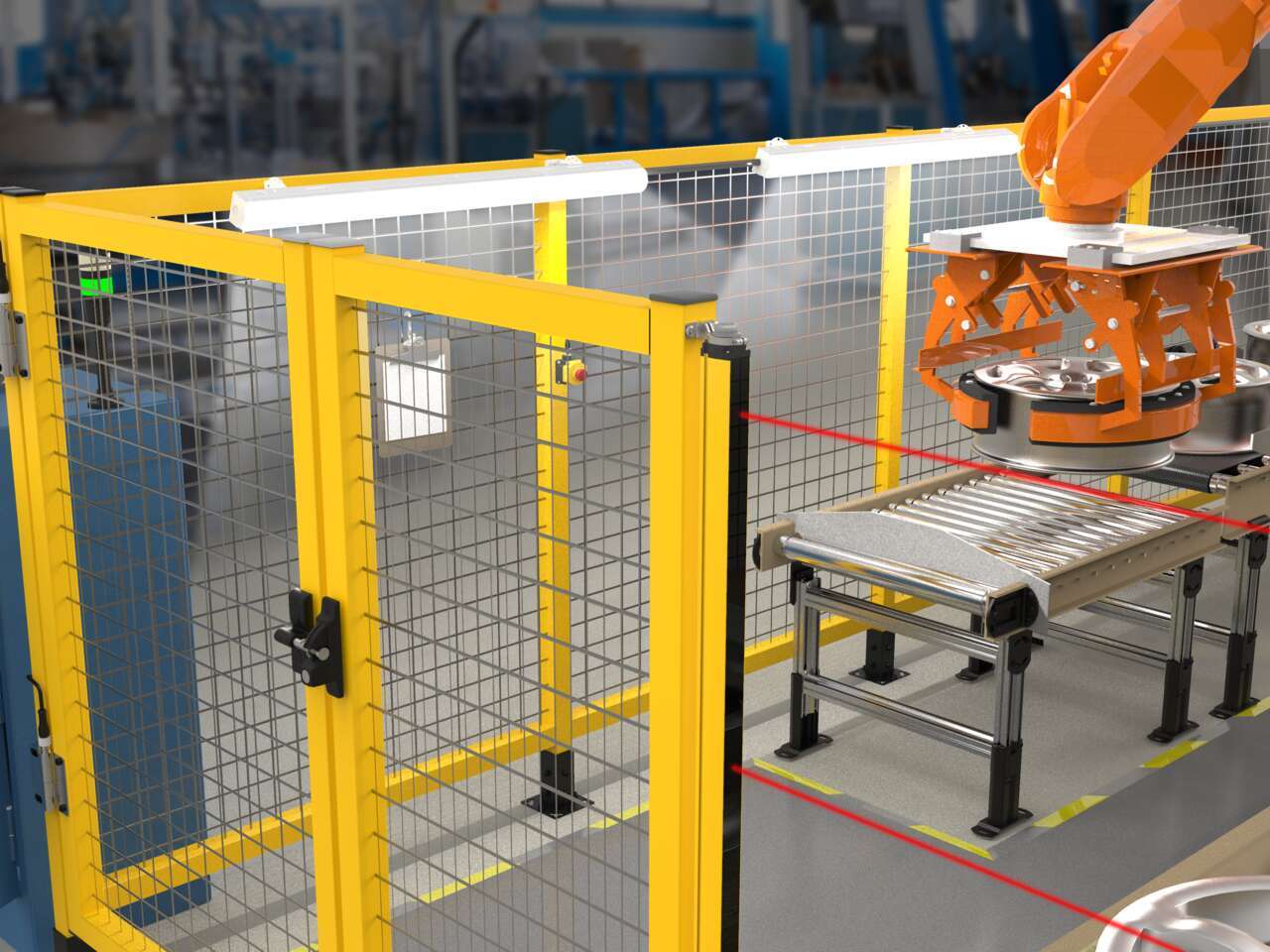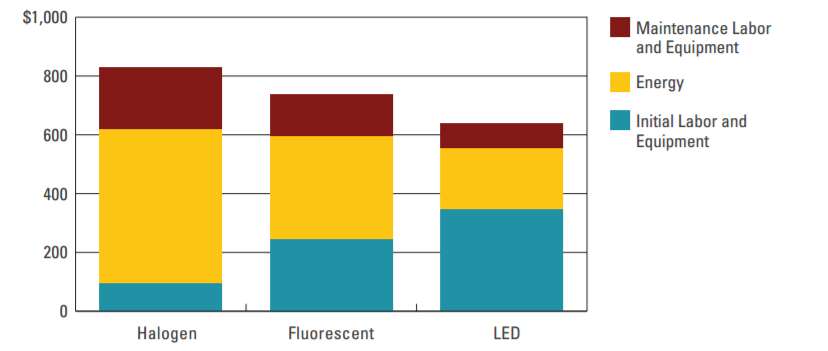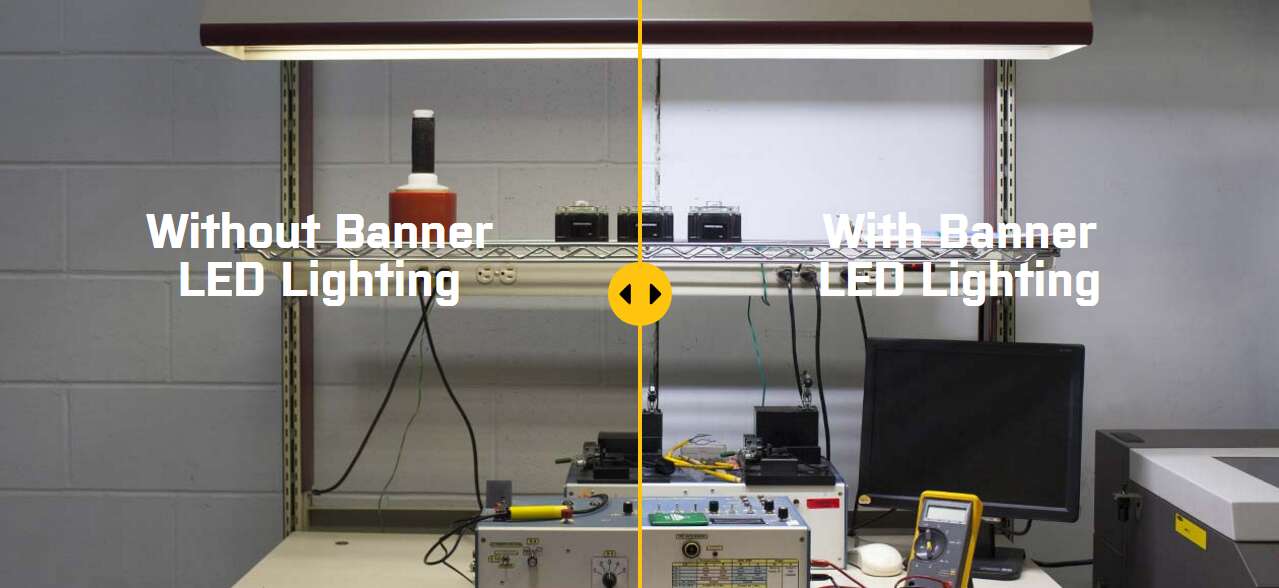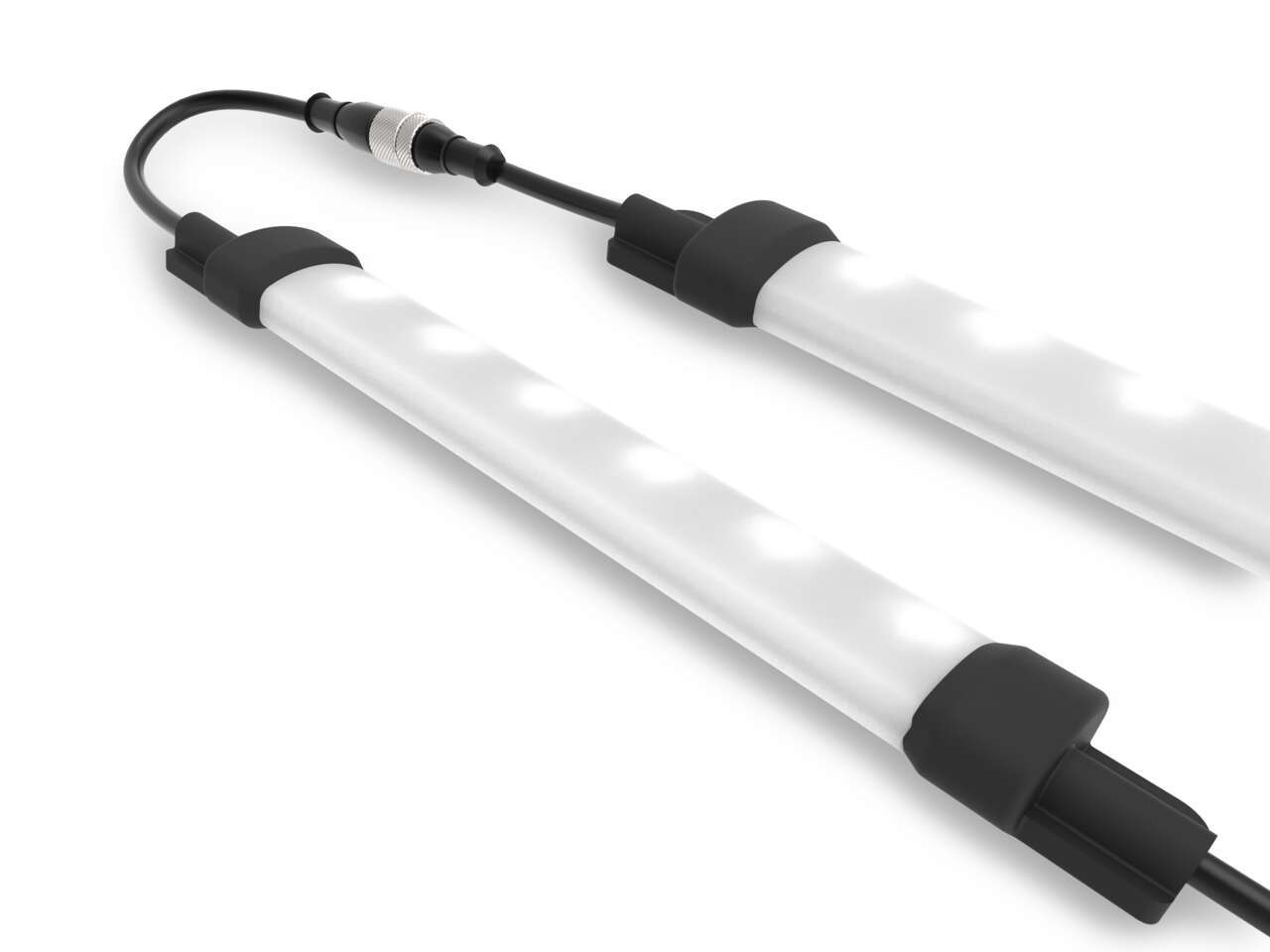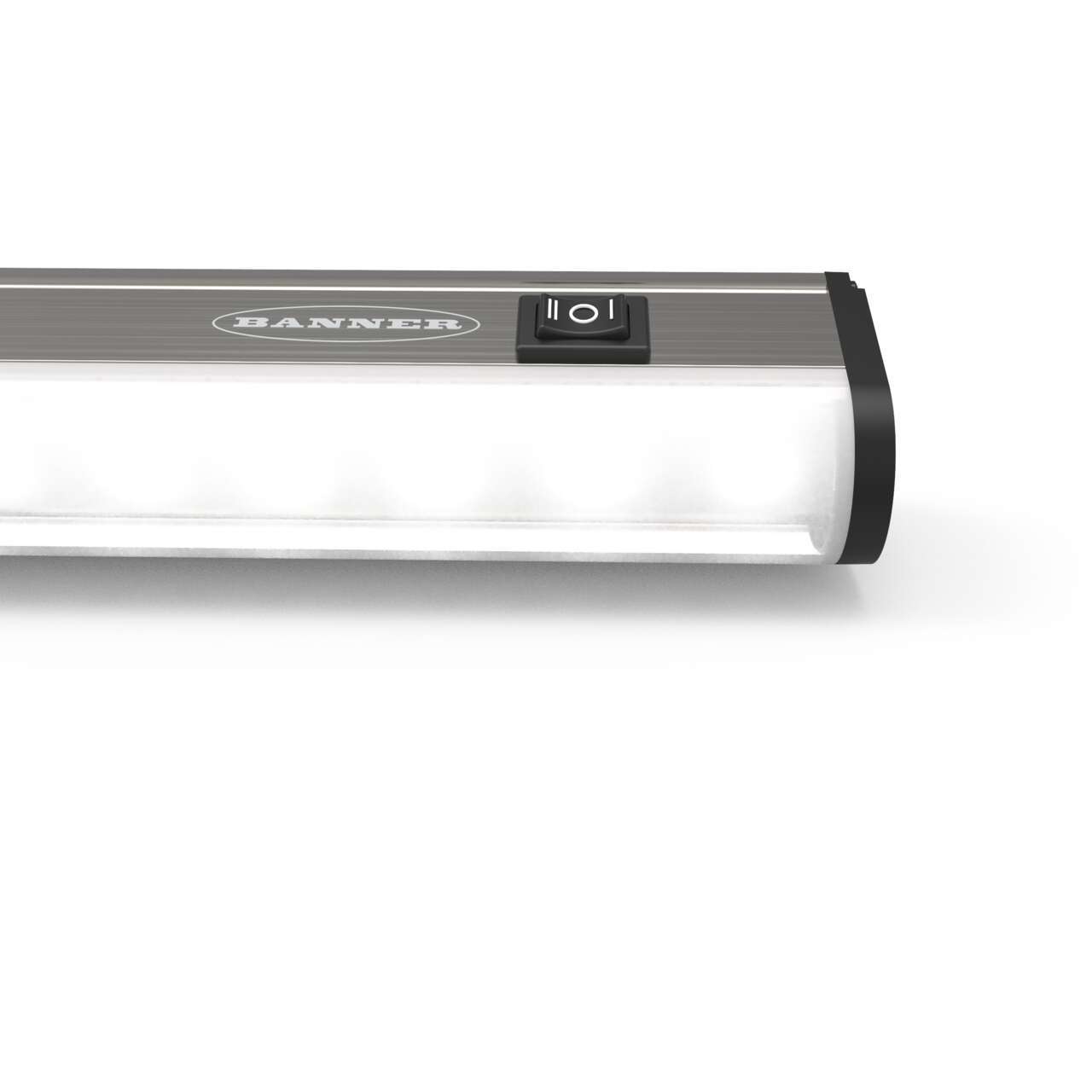LED Lighting for Manufacturing: Save Costs While Improving Productivity
Saving money is an important consideration for most industrial users. Even if lighting does not account for a large share of the operating budget, every bit of savings can help the bottom line. Upgrading lighting can be an effective way to reduce facility and machine costs while improving the productivity, safety, and functionality of a space.
Costs of Ownership
When considering lighting costs, industrial users should recognize that the initial cost of a light is only part of the life-cycle cost of the lighting solution. Maintenance and lamp replacement costs depend on the lifetime of the equipment, and the energy costs depend on the equipment’s efficiency. For this reason, longer-lasting and more-efficient technologies can produce significant savings, even if they are initially more expensive.
The image below illustrates the costs of a lighting solution over a 15-year cycle, assuming typical costs, wattage, and lifetimes, for different technologies. Industrial users should calculate the lifetime costs of the specific equipment options they are considering before making a decision.
LED fixtures often have higher initial costs for a given application than other technologies; however, they often are the most efficient option available and have the longest lifetime. Some industrial users may find fluorescent or HID technology better suited to their needs, but that may not be the case for much longer given the rapid pace of advancements in LED technology.
Initial Costs of Lighting
The initial equipment costs for a lighting solution include the housing, electrical equipment (e.g., the ballast or driver), and the light engine (e.g., the lamp or LED panel). LED equipment is often more expensive than competing technology options, and the difference can be significant for certain applications.

Industrial users may also find that the initial cost of the lighting housing depends on the environment. As discussed below, some lighting can withstand the extreme conditions that are often present in industrial environments. These safeguards may increase the cost of the equipment, but the risk of damage or injury to people or other materials in the space is reduced—ultimately saving costs long term.
Different types of lighting upgrades require different investments in equipment. Lighting upgrades can be classified as retrofits or redesigns. Retrofits involve replacing the existing lights with more-efficient technologies, while making use of the existing housing, lighting pattern, and electrical equipment. On the other hand, redesigns require new fixtures, modification of the existing lighting pattern, and partial or complete rewiring of the electrical system.
Both retrofits and redesigns can involve upgrading to more-efficient technologies, increasing or decreasing the total amount of illumination, and/or adding lighting controls. Both upgrade types can be simplified significantly by using fixtures with features like electrical cascading, integral wire connectors, and varied mounting options.
Industrial users should consider a redesign of the lighting system if any of the following situations apply:
- The existing lighting solution is in poor condition
- The light distribution of the existing solution is uneven
- The light distribution of the existing solution does not suit the uses of the space (e.g., if there have been changes in the design, components, furnishings, or conditions in the space)
- The desired illumination or distribution cannot be achieved with the available retrofit options
Image: Proper illumination for workstations can be a cost-effective, long-term solution to increasing ergonomics and productivity.
Operational Costs
Small improvements in efficacy can result in significant operating cost savings over the lifetime of a lighting solution. Achieving appropriate levels of light for work areas by using focused task lighting can also save on operating costs. Lighting controls that dim or turn off lights when they are not needed is another way to reduce operating costs.
Efficacy ratings vary significantly among different technologies and applications, from less than 15 lumens per watt (lm/W) for standard 60W incandescent lamps, to nearly 150 lm/W for the latest LED area lighting.
Generally, lights with higher lumen outputs have higher efficacy ratings. LEDs often have better efficacy than other technologies, but highly efficient fluorescent and HID options can provide better or similar efficacies for some applications. Reducing the lighting system’s power will also save on demand charges.
When commercial or industrial customers significantly reduce their power draw, they should review their utility rates schedules to determine which schedule is most economically attractive. Large customers that face “ratchet” charges may benefit by shifting to a different schedule if demand reductions are significant. Taking ratchet charges into account may significantly improve the cost-effectiveness of more-efficient technologies.
Image: The WLS15 is a low-profile, low power LED task light ideal for tight spaces like cabinets as well as mobile and battery-operated applications.
Maintenance Costs
Industrial users should understand the maintenance costs associated with a lighting solution. Having a plan in place for routinely replacing lamps and cleaning surfaces can reduce the total amount of labor needed for maintenance. Maintaining the appearance and uniformity of the lighting can also help with workplace safety and productivity.
The performance of any lighting solution will deteriorate over time through the failure of lamps, ballasts, or drivers; gradual lumen depreciation and color shift; or the accumulation of dust and dirt on lenses and reflector surfaces. The deterioration rate can be determined by the system’s operating profile, the system’s technical characteristics, and the conditions of the operating environment. To plan effectively, it is important to attempt to predict the lifetime of a given technology and understand how and when the lighting system will likely deteriorate.
Image: The WLB32 LED workstation light provides long lasting, maintenance-free illumination for workstations.
LED technology is treated differently from non-LED technology in this regard. LED chips degrade slowly over time, producing less light and shifting their color characteristics. The metric used to define the lifetime of LEDs is L70 lumen maintenance. This refers to the amount of time the LED will operate while maintaining at least 70 percent of initial output. Some LEDs will take longer to get down to 70 percent.
Non-LED technologies have electrical components or filaments that fail completely at some point; the rated lifetime for those products is defined as the number of hours of operation at which 50 percent of the units in a sample fail. Non-LED technologies also experience depreciation in lumen values over time, with some technologies depreciating more quickly than others.
The following presents a range of rated lifetimes and lamp lumen depreciation (LLD) values at the end of the rated life for selected technologies.
| Lighting Technology | Rated Lifetime (Hours) | Lamp Lumen Depreciation (LLD) at end of rated life |
|---|---|---|
| Lighting Technology Hallogen Incandescent | Rated Lifetime (Hours) 3,000 - 5,000 | Lamp Lumen Depreciation (LLD) at end of rated life 5 percent |
| Lighting Technology Linear Flourescent | Rated Lifetime (Hours) 15,000 - 45,000 | Lamp Lumen Depreciation (LLD) at end of rated life 10 percent |
| Lighting Technology High Pressure Sodium | Rated Lifetime (Hours) 15,000 - 40,000 | Lamp Lumen Depreciation (LLD) at end of rated life 30 percent |
| Lighting Technology LED | Rated Lifetime (Hours) 20,000 - 50,000+ | Lamp Lumen Depreciation (LLD) at end of rated life — |
Source: Rated lifetimes from David L. DiLaura et al., eds., The Lighting Handbook, 10th ed., 13.7; LLD from Illuminating Engineering Society and InterNational Association of Lighting Management Companies, Recommended Practice for Planned Indoor Lighting Maintenance: IESNA/NALMCO RP-36-03, 2.
The projected L70 value for LEDs can exceed 50,000 hours, but manufacturers are encouraged not to claim a longer rated lifetime because of uncertainties of the projection methodology. In addition, the LED chips often last longer than the drivers that power them, which means that industrial users may need to replace drivers before the light engine needs to be replaced.
The maintenance schedule for a lighting solution should also account for the amount of dirt and dust in the operating environment. Dirt accumulating on a lamp lowers the light output and can skew the light distribution; dirt accumulating on reflective surfaces, such as walls and ceilings, can also lower total illumination. Regular cleaning, painting, and general upkeep can help ensure that the lighting solution operates at its highest level.
Conclusion
The costs of ownership are just one consideration to take into account when identifying an illumination solution. To learn more, download the white paper: Considerations for Lighting in a Manufacturing Environment.
